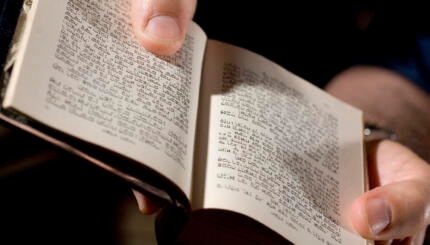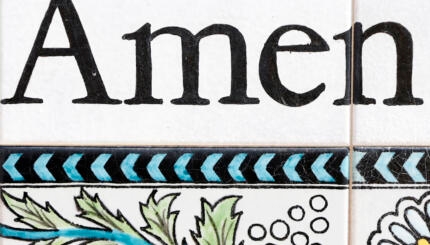The Amidah is the core of every Jewish worship service, and is therefore also referred to as HaTefillah, or “The prayer.” Amidah, which literally means, “standing,” refers to a series of blessings recited while standing.
Find a version of the Shabbat Amidah in Hebrew here, or consult a prayer book of your choice.
Using the image of master and servant, the Rabbis declared that a worshipper should come before his or her master first with words of praise, then should ask one’s petitions, and finally should withdraw with words of thanks. Thus, every Amidah is divided into three central sections: praise, petitions and thanks.
Originally, Jewish prayer was largely unstructured. Although the Rabbis eventually codified the format and themes of each of the blessings, it was initially left to the creativity of individual prayer leaders to generate the specific wording of the blessings. Individual communities in different countries began to settle on somewhat standard versions of the prayers over time. Today the variations between the traditional texts of the Amidah in different communities are fairly minor.
With your help, My Jewish Learning can provide endless opportunities for learning, connection and discovery.
The Amidah is recited silently by all members of a congregation — or by individuals praying along — and then, in communal settings, repeated aloud by the prayer leader or cantor, with the congregation reciting “Amen” to all the blessings of the Amidah.
The First Three Blessings
The first three blessings of praise of the Amidah in every worship service are always the same, with only minor variations for weekdays, Shabbat and holidays. The first blessing is called Avot, Hebrew for “ancestors,” and serves as an introduction to the God of our biblical heritage, connecting us to the Divine. Immediately before reciting the Amidah, the tradition developed of taking three steps backward and then forward again to symbolize entering into God presence. Mentioning the patriarchs Abraham, Isaac, and Jacob–and in liberal congregations, the matriarchs, Sarah, Rebecca, Leah, and Rachel–this blessing praises God for remembering their good actions, and by implication, asking God to hear our prayer favorably because of their merit. The blessing begins and ends with a formal bow at the knees and hips, symbolically demonstrating our subservience to God.
The second blessing of praise is called Gevurah (might), which describes those powers which are only within the purview of the Divine: “Your lovingkindness sustains the living, your great mercies give life to the dead.” Articulating a fundamental Rabbinic belief in resurrection, this blessing is a reminder of God’s absolute power of life and death.
The final blessing of this opening section of praise is called the Kedushah, or holiness. There are two versions of this prayer, one when recited silently by individuals, the other, much longer, is a series of prayers and responses by the leader and congregation when the Amidah is repeated on behalf of the community.
Both of these prayers emphasize the holiness and sacred nature of God. The individually-recited version simply states, “Holy are You and holy is Your name. Holy are they who praise you daily.” The core of the communally repeated blessing is derived from the biblical prophet Isaiah’s vision of God in the heavenly Temple surrounded by the angels singing praises (Isaiah chapter 6).
Isaiah described the angels calling one to another, echoing the phrase, “Holy, holy, holy is the Lord of Hosts, the whole world is filled with His glory.” This verse is introduced by claiming that the human chorus of voices imitates the heavenly chorus, and thus, in a choreography designed to reflect angels, individuals rock up upon the balls of their feet three times, for each word “holy” that is said, symbolizing the fluttering of the angels who recited this line of praise. Several more biblical verses are also recited, ending in the blessing, “Praised are You, Adonai, the holy God.”
The Middle Section
On weekdays, the middle section of the Amidah consists of 13 blessings that are individual and communal requests to God. Originally consisting of only 12 petitions, the total number of blessings recited was 18, hence, an early synonym for the Amidah was the Shemonah Esrei, or the Eighteen. However, in Rabbinic times another blessing was added resulting in a total of 19, yet the original name of the Shemonah Esrei was retained.
Of these 13 requests recited during the weekday Amidah, the first five are essentially personal, or individual requests to God to improve the situation of each person. The individual prays to God to grant us intelligence and understanding, give us the ability to repent of our transgressions, for God to be gracious and forgiving, to send a redeemer, or messiah, to the Jewish people to end our affliction, and finally, to grant healing to those who are sick and ailing. Despite the individual nature of these requests, the language of the prayers are all in the plural emphasizing the corporate nature of even singular Jewish identity.
The following eight blessings are focused more explicitly on the communal and national needs of the Jewish people. There is a request for rain or dew in the proper season to ensure agricultural bounty, a plea to end the dispersion of the Jewish people, and prayers to restore true judges and establish justice in the world; to humble the arrogant and those who seek to malign and injure the Jewish community; to sustain the righteous of the house of Israel; rebuild Jerusalem; reestablish a Davidic leadership; and a final petition to hear and answer the prayers of the Jewish people.
On and holidays, instead of requests that might distract us by reminding us of our physical and national wants and needs, the Rabbis established the middle section as an opportunity to celebrate the holiness of the Sabbath day and/or the festival. On Shabbat morning, the entire middle section of the Amidah describes Moses receiving the Ten Commandments followed by the verses from the book of Exodus (31:16-17) that describe the observance of Shabbat as a sign of the covenant between God and the Jewish people. Furthermore, Shabbat is summarized as a gift given only to the Jews out of God’s love for His people. It concludes with a blessing thanking God for sanctifying the Shabbat.
On festivals, particularly the pilgrimage holidays of Pesach, Shavuot, and Sukkot, the middle portion of the Amidah similarly describes how God has given these holidays as a gift to the Jewish people for joy and celebration. There are also references to the biblical patriarchs, King David, and Jerusalem to be remembered in glory. Despite the official absence of requests, the holiday prayers of the Amidah do in fact ask that God enable us to enjoy and celebrate the holiday with gladness of heart and conclude with a blessing thanking God for sanctifying the people of Israel and the holiday.
The Final Section
The final section of every Amidah concludes with blessings of thanksgiving to God; like the first three blessings, these are identical for weekday, Shabbat, and holiday versions of the Amidah. The first of these is called Avodah, which means service, referring to the service of animal sacrifices in the days of the Temple. This prayer asks that God accept our prayers as were the animal sacrifices of old and concludes by thanking God for (ultimately) restoring God’s presence to Zion, referring to both the land of Israel and the city of Jerusalem.
The second concluding prayer of thanksgiving is called Hoda’ah, or thanks. This prayer thanks God for the gift of our lives and for the daily miracles which God bestows upon the world each day. The beginning and end of this prayer are marked by a bow at the hips, once again symbolizing the depth of our gratitude to God.
At this point during the reader’s repetition of the Amidah, the reader recites the three-fold priestly blessing, with the congregation responding, “So may it be God’s will” after each line:
“May the Lord bless you and keep you
May the Lord cause His favor to shine upon you and be gracious unto you
May the Lord lift His favor unto you and give you peace” (Numbers 6:24-26).
Although customs vary, traditional synagogues outside of Israel have the congregants who are kohanim (of the priestly family) ascend and invoke God’s blessing upon the congregation by reciting this blessing on the holidays; in Israel, this is done every Shabbat, and in Jerusalem, every day.
The final prayer of thanksgiving to God is actually a final petition to bestow justice, mercy, and peace on the world. Called Shalom, or peace, the community asks that God grant peace, goodness, blessing, and compassion upon everyone; the themes and language are clearly derived from the priestly blessing that precedes it. A different but parallel version of this prayer is recited in the afternoon and evening Amidah prayers.
Although the official structure of the Amidah concludes with the prayer for peace, the Rabbis of antiquity added on private, personal meditations. The fairly standard version, which appears in most siddurim (prayer books) is the concluding meditation of Mar bar Ravina from the time of the (Berachot 17a).
However, it is appropriate for individuals to recite their own prayers as well as this point. The Amidah then formally concludes with the recitation of the line, “May God who brings peace to the universe, bring peace to us and all of the people, Israel. Amen.” This is recited while taking three steps backward, bowing to both sides, and taking three steps forward again, formally retreating from God’s symbolic presence.



